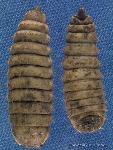I started a little vermiculture bin year before last with one cup of red wigglers from the local bait shop. I carefully sorted my garbage so there was no grease or animal protein in the bin and counted the worms every Saturday. Yes, I was a little obsessive about it.

Credit: Bianca Diclaro, University of Florida
Credit: Bianca Diclaro, University of Florida
The initial population was twenty-four and during the cold month it had gotten down to twelve. The bin finally rebounded. The last time I counted, there were 499 worms. I spent an hour looking for another to make a round 500 but gave up. I decided my bin must be doing all right and let it drift into a period of what I assumed was benign neglect.
The next time I stirred up the bin I saw large flattened maggots that made me think I’d made a BIG mistake. The wigglers were still working, but I was mortified they might be in serious danger of compost collapse.

A little research revealed they are the larvae of the Black Soldier Fly (BSF). Being a fly it lacks a stinger.
Turns out the fly is an outstanding composter of animal manure and animal protein as well as a deterrent to nuisance flies. It is being used on a industrial scale to turn offal into compost/fertilizer and the larvae make great fish or poultry feed.
They had come to my worm bin because I had let it get wetter than the perfect red wiggler moisture level and because I had become lax in my garbage sorting. Instead of a problem, I had a bonus.
Mature larvae move to a dryer space to pupate. This tendency allows backyard MacGyvers to assemble a bin with a spout to deliver the larvae directly to the chicken yard or fish pond. What looks like an icky monster is really another natural wonder with lots of applications.
Check these links for more information on the Black Soldier Fly and how it can complement your red wigglers.
http://edis.ifas.ufl.edu/in830
http://aggie-horticulture.tamu.edu/galveston/beneficials/beneficial-51_black_soldier_fly.htm
 0
0
